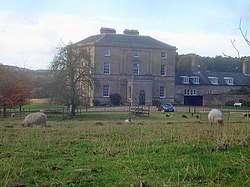Papplewick Hall
| Papplewick Hall | |
| Nottinghamshire | |
|---|---|
 Papplewick Hall | |
| Location | |
| Grid reference: | SK54825174 |
| Location: | 53°3’36"N, 1°11’0"W |
| History | |
| Built 1787 | |
| For: | Hon. Frederick Montague |
| Country house | |
| Information | |
Papplewick Hall is a country house in Papplewick in Nottinghamshire.
In its history, this has been the home to a number of families, Today, still a private home, it is a Grade I listed building.[1]
History
The Hall was completed around 1787[2] for the Hon. Frederick Montagu, and is probably the work of William Lindley of Doncaster.[3]
Frederick never married, and on his death in 1800 the Papplewick estate passed into the hands of his niece, Catherine Judith Fountayne, for her lifetime. Catherine lived at Papplewick until 1822 but did not marry. On her death the Estate came to Richard Fountayne Wilson of Melton-on-the-Hill. He gave it by Royal Licence to his 10-year-old son, Andrew, in 1826.
Andrew Montagu took charge of the 1,758-acre estate during 1840 and moved into Papplewick Hall from his home at Normanton, Rutland. He never married and on his death in 1895, the Papplewick Estate was left in trust, for his brother's youngest son, James Fountayne Montagu.
James inherited the Estate on his 25th birthday in December 1912, and he developed it as a horse breeding centre. However, the First World War intervened. After the war he ran up large debts. In April 1919, Alderman Albert Ball emerged as the purchaser of the Papplewick Estate for the hitherto undisclosed sum of £136,410.
Subsequent sales divided the estate between the Hucknall Torkard Industrial Provident Society which purchased 1,058 acres in Papplewick and Linby, whilst Sir Charles Seely, 2nd Baronet took another 444 acres centred on Forest Farm.
The house and grounds are privately owned.
| ("Wikimedia Commons" has material about Papplewick Hall) |
References
- ↑ National Heritage List 1265296: Papplewick Hall (Grade I listing)
- ↑ The Great Houses of Nottinghamshire and the County Families, L Jacks, 1881
- ↑ Notes on Papplewick, in J Potter Briscoe, ed. Old Nottinghamshire, 1884